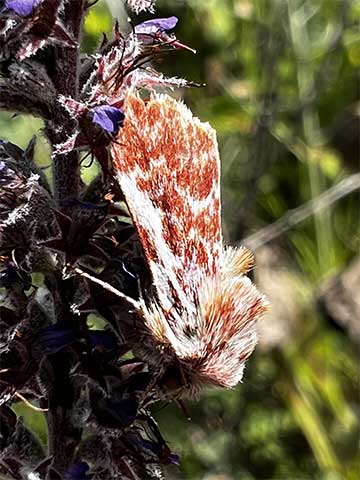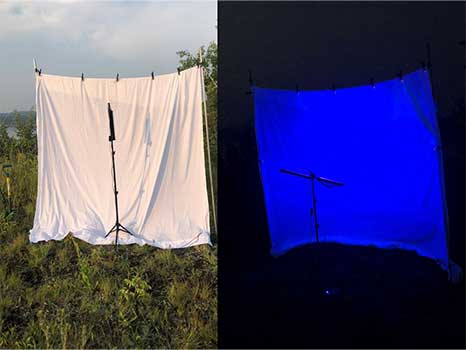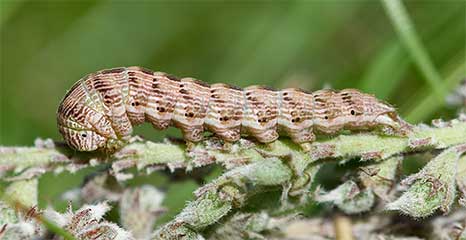Moths, Caterpillars, and Restoration of Remnants
By Robert J. Marquis
October 1, 2023

The goal of The Prairie Enthusiasts is to preserve and restore prairies and savannas in the Upper Midwest. By this we mean the protection of the entire ecosystem, not only the plants but also the animals and microbes and all their intricate interactions with those plants and each other. It has long been feared that conservation efforts might result in “empty forests” (or in our case, “empty prairies”) in which the landscape appears to be intact but close-up, many if not all the once known animal inhabitants are missing. A major challenge is to document the effects of prairie and savanna management on the animal participants and their place in prairie food webs.
The St. Croix Valley chapter in conjunction with Minnesota Department of Transportation (MNDOT) has managed a small remnant prairie (15 acres) for 18 years. This prairie, known as the Blueberry Hill Prairie, lies on the western bluff (Minnesota side) of the St. Croix River, just opposite Hudson, Wisconsin. Beginning in 2013, volunteers of the chapter began to convert 11 acres of adjacent agricultural land into prairie. In 2023, the chapter initiated efforts to document the interactions between insects and plants that occur in the Blueberry Hill Prairie.

Black light setup before sunset (left) and after in the dark (right). Photographs by R. Marquis
The Leadplant Flower Moth is endangered in Michigan (Michigan DNR 2023) and Indiana (Indiana DNR 2023), of special concern in Minnesota (Minnesota DNR 2023), and of greatest conservation need in Wisconsin (Wisconsin DNR 2023a). It is highly specialized in habitat, food plant, and phenology, and it is this combination of characteristics that makes it vulnerable. In the Upper Midwest, it is found only on prairie, caterpillars feed only on leadplant, and then only on the flowers and developing fruits of the plant. This lifestyle forces it into a very narrow time window of activity. In the Upper Midwest, we might suspect that caterpillars of this species could also survive and mature on fruits of Amorpha fruticosa (indigo bush), given that even highly specialized species often can feed on more than one member of the same plant genus. But there are no feeding records for A. fruticosa (Robinson et al. 2002), perhaps because that plant in Wisconsin and Minnesota grows in moist woodlands, along streams, and in floodplains. The moth does occur outside of the range of A. canescens, meaning that it must feed on additional host plant species.

Citations
Henderson, R. 2017. Of checks, balances & seed production. The Prairie Promoter 30:6,8.
Hess, M., and M.J. Hatfield. 2015. One plant at a time. The Prairie Promoter 28:1,4.
Indiana DNR. 2023. Indiana county endangered, threatened and rare species list. https://www.in.gov/dnr/nature-preserves/files/np-Indiana-County-Endangered-Threatened-Rare-Species-List.pdf. Accessed 30 August 2023.
Michigan DNR. 2023. Threatened and endangered species list. https://www.michigan.gov/dnr/managing-resources/wildlife/wildlife-permits/threatened-endangered-species/threatened-and-endangered-species-list. Accessed 30 August 2023.
Minnesota DNR. 2023. Minnesota’s endangered, threatened, and special concern species. https://www.dnr.state.mn.us/ets/index.html. Accessed 31 August 2023.
Robinson G.S., Ackery P.R., Kitching I.J., Beccaloni G.W., Hernández L.M. 2002.
Hostplants of the moth and butterfly caterpillars of America north of Mexico. Memoirs of the American Entomological Institute, v. 69, 824 p.
Summerville, K.S., Bonte, A.C. and Fox, L.C., 2007. Short‐term temporal effects on community structure of lepidoptera in restored and remnant tallgrass prairies. Restoration Ecology, 15(2), pp.179-188.
Swengel, A.B. and Swengel, S.R., 2006. Variation in detecting Schinia indiana and Schinia lucens (Lepidoptera: Noctuidae) in Wisconsin. The Great Lakes Entomologist, 39(3 & 4), p.6.
The Lepidopterists’ Society. 1983. Season summary. News Lepidoptera Society, no. 2.
The Lepidopterists’ Society. 1984. Season summary. News Lepidoptera Society, no. 2.
Wisconsin DNR. 2023a. Species of great conservation need. Wisconsin wildlife action plan. https://dnr.wisconsin.gov/topic/WildlifeHabitat/actionPlanSGCN. Accessed 30 August 2023.
Wisconsin DNR. 2023b. Wisconsin’s endangered and threatened species list. https://dnr.wisconsin.gov/topic/EndangeredResources/ETList . Accessed 30 August 2023.
Want to stay up-to-date on events like this happening in the St. Croix Region? Send us an email to make sure you’re on their chapter email list.
